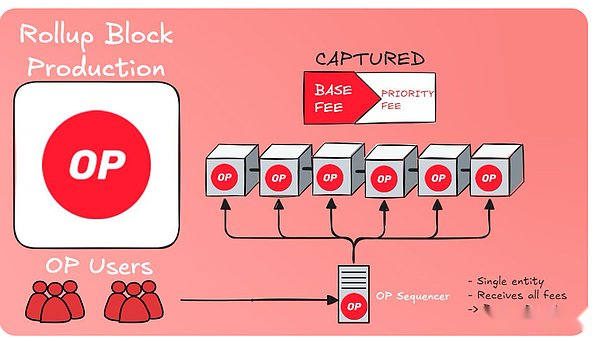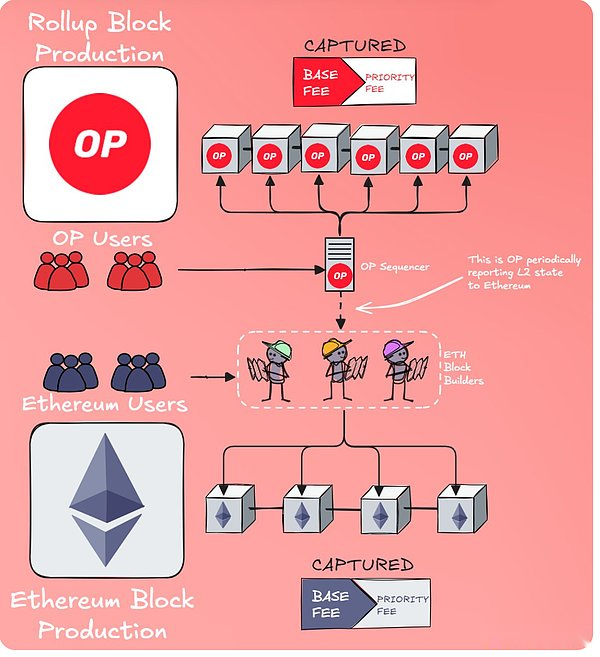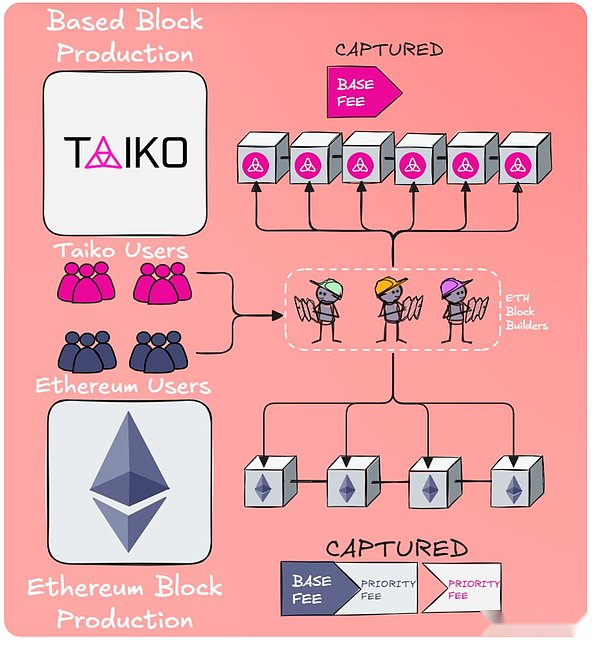
Author: BREAD Source: X, @0xBreadguy Translation: Shan Oppa, Bitchain Vision
If you’ve heard any debate about L2, you must have heard of “Based” rollup.These are different from “Optimistic” and “Zero Knowledge (ZK)” rollups because they are considered to be more synergistic with mainnet Ethereum.
We will start from scratch (vocabulary), touch the “normal” blockchain, and end with the build itself of Based™️.
Glossary
First, let’s review a few terms and key roles so we don’t have to waste time Google searches.
Role
-
Sequencer:A single machine run by the L2 team, responsible for collecting user transactions and determining the order in which they are packaged into the L2 block, and finally submission to L1 in batches.
-
Block Builders:These participants are part of the sorter equivalent assembly line on the mainnet Ethereum.These entities receive user transactions (public or private), maximize profits through a specific sorting method, and ultimately pass them to the validator to formally incorporate them into the block.
Terms
-
Base Fee:This is the minimum amount the user enters into any given block, and its pricing is determined by the congestion situation.(For example, if the gas utilization rate of block 10 exceeds 50%, the minimum cost of block 11 will rise).This fee will be destroyed on Ethereum and some L2.
-
Priority Fee:This is the “tip” you are willing to pay on top of the underlying fee to get priority in the block (i.e., you are the first transaction to execute in a given block).
If you have mastered the above, you will be able to keep up and understand why rollups based is different from what we are used to.
Ethereum Block
To lay the foundation, let’s discuss how to create Ethereum blocks and which projects in our vocabulary are important.Visual image:

Now let’s discuss the process:
-
Ethereum users to BuildersSubmit a transaction
-
These transactions represent the maximum fee for the user and will cover the includedBasic fees(Destroyed) and use the remaining cost increments asPriority Fees/Tips(Reserved by the builder)
-
The builder then handed over these blocks to the validator, who will submit these blocks to be included in the canonical chain
Ultimately, the fees paid by the user are 100% of the participants in the ETH asset (by destruction) or in the Ethereum block building supply chains (called “Builders” here).
The former mechanism is seen as an agnostic alternative to direct public goods funding, while the latter provides incentives for key components of the Ethereum block building process.Both are (usually) considered to have a value-added effect on the entire network.
Now let’s look at the typical L2.
Traditional Rollup blocks
Taking Optimism as an example, we can maintain the same relative structure as Ethereum, simply swap Builders (a collection of competing entities) to Sequencer (a single machine run by the team behind Optimism).
Visualization:

Again, follow this process and you will find that they are very similar:
-
Optimism users submit their transactions toOP Sequencer
-
Like Ethereum, these transactions will indicate the maximum fee for the user, covering the basic fee (the OP Stack chain destroys this fee, but not all L2s do this [e.g. Arbitrum]) and use the remaining fee increment as a priority fee/tip (Keep by the team running the sequencer)
-
Then, Sequencer sorts the transactions, proposes the next block to the canonical chain, and updates the L2 status/worldview to the mainnet Ethereum
It is important to note here that end user relationships and 100% of the fees are owned by the sorted entities (i.e. they remain in the L2 ecosystem).How the entity (whether it is Optimism, Base, Arbitrum, or Blast) handles these fees is entirely at their discretion.
– Some people burn the basic expenses and put the priority expenses (basic expenses) into their own pockets.- Some people will give both to token holders (Arbitrum).- Others will return part of the funds to the developer on the chain (Blast).
But if L2 captures all these fees, how can Ethereum benefit?Let’s talk about how these two block construction processes are combined…
Traditional Rollup + Ethereum Block
As always, visualize first:

As you can see, in order to connect two separate block building processes together (a line), not much is added.
This line regularly publishes data to the Ethereum mainnet on behalf of the L2 sequencer so that L2 can provide some security (such as forced inclusion) to L2 users.
Note: Ethereum cannot specify the time for any given L2 to publish transactions, which means that the pace and efficiency of the release are fully in the hands of the submitter.
All in all, it is quite beneficial for traditional L2s, which can capture all the expenses incurred within their ecosystem and control their largest single expenditure (posting to the mainnet) because it is arbitrary.
review
OK, we have laid the foundation for solving the mystery.Recalling the most important concepts in traditional concepts so that we can delve into differentiation-based factors:
-
The Ethereum block is constructed by competing and unrelated parties.
-
Traditional Rollup blocks are built by a sorter run by the Rollup team
-
Each block build process captures 100% of the charge in this ecosystem and Ethereum/L2 is linked via a casual L2 release pace
Based Rollup + Ethereum Block
The reason we don’t need to start with graphics-based graphics is that the construction of Based is relatively simple (which makes them elegant).
They asked “Why don’t we use Ethereum directly as our sequencer?” So they did this by leveraging the builders of our Ethereum block build section.
Visualization

You might ask, how does this work?The process itself is not much different from traditional Rollups, but the user experience is somewhat subtle.
flow
-
Users send their transactions to builders who choose to be Ethereum and L1 building blocks based on L2.
-
Users specify their maximum fee
-
L2 captures the base fee (determined by L2 congestion) and passes the priority fee/tip to the L1 builder responsible for ordering.
In this model, Ethereum can capture not only 100% of its own ecosystem, but also a portion of L2 tips beyond the settlement release cost.
In exchange, Based L2 inherits:
-
Ethereum activity (i.e., as long as Ethereum is processing blocks, the L2-based blockchain will continue to run, and if a single sorter of a traditional rollup fails, the entire chain may stop running), and
-
Ability to atomically combine with the L1 state (e.g., exchanges on L2 can interact with L1 liquidity).
But it is not without its shortcomings, because so closely intertwined with Ethereum means that Ethereum-based teams will sacrifice some profitability (priority fees) and must also bear the resistance associated with the Ethereum mechanism (like 12 seconds ofBlock time).
These things can be mitigated through mechanisms such as pre-confirmation, but they still have to be considered.
Review and Prediction
So, can Based Rollups solve all of our L1<>L2 economic relations issues and the future of Ethereum?
I actually doubt many teams will choose to use Based, as this will directly affect their business bottom line.Thankfully, some of their advantages (L1 atomic composability) are attracting builders, so we can at least see the progress of the experiment.
There is also an interesting study in progress in Taiko Gwyneth and Spire, known as “Next Generation Based,” which emphasizes that L1 applications run their own underlying application chains, obtain priority fees and maintain composability with L1 contracts.I will pay close attention to this.
If the Ethereum Rollup ecosystem had been based on this from the very beginning, I believe its narrative stance would be better than today, but things are unpredictable.








